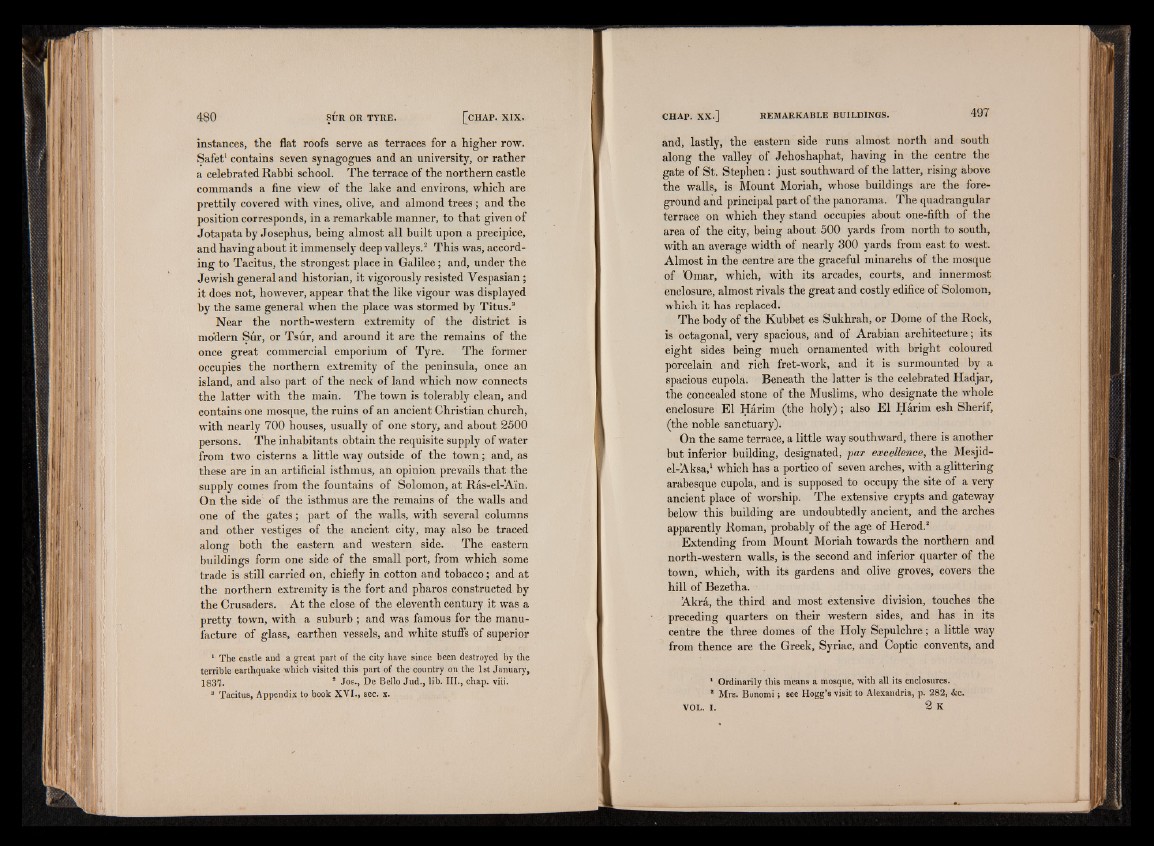
instances, the flat roofs serve as terraces for a higher row.
Safet* contains seven synagogues and an university, or rather
a celebrated Rabbi school. The terrace of the northern castle
commands a fine view of the lake and environs, which are
prettily covered with vines, olive, and almond trees; and the
position corresponds, in a remarkable manner, to that given of
Jotapata by Josephus, being almost all built upon a precipice,
and having about it immensely deep valleys.2 This was, according
to Tacitus, the strongest place in Galilee; and, under the
Jewish general and historian, it vigorously resisted Vespasian;
it does not, however, appear that the like vigour was displayed
by the same general when the place was stormed by Titus.3
Near the north-western extremity of the district is
mo'dern Sur, or Tsúr, and around it are the remains of the
once great commercial emporium of Tyre. The former
occupies the northern extremity of the peninsula, once an
island, and also part of the neck of land which now connects
the latter with the main. The town is tolerably clean, and
contains one mosque, the ruins of an ancient Christian church,
with nearly 700 houses, usually of one story, and about 2500
persons. The inhabitants obtain the requisite supply of water
from two cisterns a little way outside of the town; and, as
these are in an artificial isthmus, an opinion prevails that the
supply comes from the fountains of Solomon, at Rás-el-Am.
On the side of the isthmus are the remains of the walls and
one of the gates; part of the walls, with several columns
and other vestiges of the ancient city, may also be traced
along both the eastern and western side. The eastern
buildings form one side of the small port, from which some
trade is still carried on, chiefly in cotton and tobacco; and at
the northern extremity is the fort and pharos constructed by
the Crusaders. At the close of the eleventh century it was a
pretty town, with a suburb ; and was famous for the manufacture
of glass, earthen vessels, and white stuffs of superior
1 The castle and a great part of the city have since been destroyed by the
terrible earthquake which visited this part of the country on the 1st January,
1837. ! Jos., De Bello Jud., lib. III., chap. viii.
and, lastly, the eastern side runs almost north and south
along the valley of Jehoshaphat, having in the centre the
gate of St. Stephen : just southward of the latter, rising above
the walls, is Mount Moriah, whose buildings are the foreground
and principal part of the panorama. The quadrangular
terrace on which they stand occupies about one-fifth of the
area of the city, being about 500 yards from north to south,
with an average width of nearly 300 yards from east to west.
Almost in the centre are the graceful minarehs of the mosque
of ’Omar, which, with its arcades, courts, and innermost
enclosure, almost rivals the great and costly edifice of Solomon,
which it has replaced.
The body of the Kubbet es Sukhrah, or Dome of the Rock,
is octagonal, very spacious, and of Arabian architecture; its
eight sides being much ornamented with bright coloured
porcelain and rich fret-work, and it is surmounted by a
spacious cupola. Beneath the latter is the celebrated Hadjar,
the concealed stone of the Muslims, who designate the whole
enclosure El Harim (the holy); also El Harim esh Shenf,
(the noble sanctuary).
On the same terrace, a little way southward, there is another
but inferior building, designated, par excellence, the Mesjid-
el-Aksa,1 which has a portico of seven arches, with a glittering
arabesque cupola, and is supposed to occupy the site of a very
ancient place of worship. The extensive crypts and gateway
below this building are undoubtedly ancient, and the arches
apparently Roman, probably of the age of Herod.2
Extending from Mount Moriah towards the northern and
north-western walls, is the second and inferior quarter of the
town, which, with its gardens and olive groves, covers the
hill of Bezetha.
Akra, the third and most extensive division, touches the
preceding quarters on their western sides, and has in its
centre the three domes of the Holy Sepulchre; a little way
from thence are the Greek, Syriac, and Coptic convents, and
1 Ordinarily this means a mosque, with all its enclosures.
1 Mrs. Bonomi; see Hogg’s visit to Alexandria, p. 282, &c.
VOL. I . 2 K